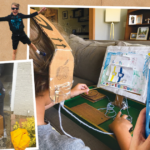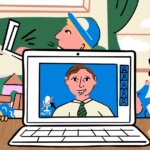






Why Banned Books Deserve a Place in Our Classrooms, Libraries, and Homes
I was always a reader. I spent my childhood pretending to be Lucy Pevensie and Jo March and Anne Shirley Cuthbert and Laura Ingalls and about a million other characters. From the ages of about 7 to 14, I lived more in books than I did in the real world.
I remember my parents restricted my reading or access to banned books very rarely. I really wanted to read The Bluest Eye when I was 10, and my mom told me I wasn’t old enough. But I read it anyway. She was right. But most of the time, my parents believed that all reading was good reading and that new ideas were crucial to helping me grow.
Banned books helped shape my world
I’m a child of the South. I grew up thinking that the Yankees were the bad guys in the Civil War. Without books like Roll of Thunder, Hear My Cry (banned for racial slurs), I might never have thought critically about the “benevolence” of white Southerners toward African Americans. I grew up in the Bible Belt. Without heroines like Meg Murray from the frequently banned A Wrinkle in Time, I don’t know how long it would have taken me to realize that girls could be more concerned with saving the world than finding a husband.
Like all adolescents, I wanted to fit in. Without The Giver, it would have been even harder for me to embrace the things that made me unique. And without The Outsiders, I’d never have developed my love for long-haired boys from the wrong side of the tracks. (Now that I think about it, maybe we should keep banning that one.)
Banned books gave me new ideas, new dreams, and a new lens through which to view the world, a lens that privileged nontraditional viewpoints. They also allowed me to think on my own and form my own opinions. For this avid reader, banned books opened a new world.
Banned books entice reluctant readers
Now I’m a middle school English teacher, and banned books are a crucial aspect of my classroom. This is partly because they get kids thinking in ways that more canonical literature might not, but mostly it’s their ability to engage reluctant readers. I’ve found that if I want to pique kids’ interest in a book, I just have to tell them they need a signed permission slip to read it.
I teach kids who catch the school bus outside of low-income housing, ride through deprived neighborhoods, and learn in a building where the heat and air conditioning frequently fail to function. (Is my job choice the result of my adolescent obsession with The Outsiders? Indubitably.) And they don’t necessarily want to read about a boy wizard at boarding school, although actually, that’s frequently banned, too. They don’t want to read about British girls desperate for husbands or anything else that seems completely disconnected from their lives. But slip them a copy of Absolutely True Diary of a Part-Time Indian, and they’ll finish it in days. Kids who have never finished a book before devour 13 Reasons Why and Yaqui Delgado Wants to Kick Your Ass like they’re a bag of chips and a cold Dr Pepper.
Banned books show kids they fit in
Call me a cynic, but I’ve noticed a common thread in most banned books: The heroes are gay. Or Black. Or Latinx. Or really tough girls. Or poor. Or people with disabilities or a mental illness. Or all of those things. Most books about wealthy, white, straight-A students don’t get banned. Nobody’s calling the library to complain about the Hardy Boys.
For many, many kids, childhood and adolescence are a minefield. Handing these kids a book that often reflects their experience isn’t going to expose them to something dangerous. Instead, it sends them the most important message they can possibly get: You are not alone. Other people have been there, too. Here’s a story about how they dealt with these issues. Learn from their mistakes. Rejoice in their triumphs. Know that you are not the only one.
Banned books start deep talks
My son is 9, and he’s into historical fiction. I’ve dreaded this for a while, because history actually really sucks. It’s basically just an endless recounting of people acting inhumanely toward other people. And my son’s a sensitive kid. Stuff he reads or sees sticks with him. I’m not necessarily ready for conversations about genocide, the Holocaust, or slavery. I want him to stay innocent, to keep his faith that the world is as good a place for everybody else as it’s been for him. Because once that faith is gone, it’s gone.
But it doesn’t matter if I’m ready for that. What matters is that he’s ready. He wants to know about injustice. Or he wants to know about the darker side of humanity. He wants to know about oppression and poverty and racism and all the things I’d rather shield him from for just a little longer. And even though it makes me sad and anxious and tired (because somehow the hard questions always come up right at bedtime), it also makes me hopeful. Because he has to know about the bad parts of the world before he can start changing them. And I’m grateful that we’re reading these books now, when he’s still willing to take me along for the ride.
Check out one of the winning essays in the Let Grow Think for Yourself scholarship contest where the student author writes about reading banned books. Or if you happen to be a high school student, ENTER the contest! Deadline: April, 30, 2022. Teachers, tell your students about the contest!



Add your comment now using your favorite social account or login to your LetGrow account.